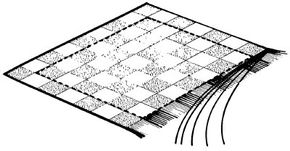How to Make a Tablecloth and Napkins
Table linens add elegance to even simple meals, but matched tablecloth-and-napkin sets are expensive. You can custom-make your own sets with very little effort, for a fraction of the ready-mades' price.
Tools:
Advertisement
- Scissors
- Tape measure
- Straight pins
- Sewing machine
- Steam iron
- Ironing board
Materials:
- Washable polyester/cotton fabric
- Thread
- If desired, fringe
Time: 1 to 3 hours
Measuring and Buying the Fabric
Choose woven polyester/cotton fabric for easy care and washability; prints are good because they don't show stains. Make the tablecloth at least 12 inches wider than the table, to overhang each end at least 6 inches; make napkins 12 inches square. For a 48-inch-square cloth and four napkins (for a 30- or 36-inch table), buy 13/4 yards of woven 48-inch-wide fabric; the fabric must be a full 48 inches wide. For a 60-inch-square cloth and five napkins, buy 21/8 yards of woven 60-inch-wide fabric. For wider tables, seam two equal widths of material together to the required width, at least 12 inches wider than the table. For rectangular tables, add length as required to make the cloth at least 12 inches longer than the table.
If desired, buy fringe to trim the edges of the cloth. Buy extra fabric as required for additional 12-inch-square napkins. The specifications given below are for a 48-inch-square cloth and four napkins; modify instructions as necessary to fit your requirements.
Cutting the Fabric
Before cutting the tablecloth, square off the end of the fabric. Spread the fabric out on your work surface. Carefully trim off a 1/4-inch-wide strip along each selvage edge. Then make a small cut close to one end of the fabric into one cut selvage edge, and grasp one crosswise thread. Gently pull the thread to draw it right out of the fabric, across the entire fabric width. This will make a line across the fabric where the thread was; cut carefully along the pulled-thread line and discard the crooked end.
Measure 48 inches from the squared corner along the cut selvage edge; make another small cut in the edge at this point and draw out another crosswise thread. Cut across the fabric on the pulled-thread line. The squared and cut piece of fabric should be 48 inches square; this is the tablecloth.
To cut the napkins, measure 12 inches along the cut selvage edge from the pulled-thread line where the tablecloth was cut. Make a small cut, draw out a thread, and cut on the pulled-thread line, as above. Divide this 12-inch strip into four equal parts; because the selvage edges were trimmed, each part will be just under 12 inches wide. Cut the four 12 × 12-inch pieces as above, drawing out a thread and cutting on the pulled-thread line.
Finishing the Edges
Making a Self-Fringe: After cutting the tablecloth and napkins, finish the edges. One of the easiest ways to finish them is by fringing -- raveling threads to make a fine, even self-fringe. To fringe the tablecloth, straight-stitch all along the raw edges, 1 inch from the edge, on a sewing machine; stitch all the way around the cloth. If your machine makes fancy stitches, you can use them here to further decorate the fringed sides.
After stitching around the cloth, carefully pull out the long threads along each edge, one at a time, to fray the material back to the line of stitching, making a 1-inch-deep fringe. To fringe the napkins, stitch 1/2 to 3/4 inch from the raw edge; pull threads as above to make a 1/2- to 3/4-inch fringe.
Attaching a Fringe: For a more casual effect, finish the edge of the tablecloth and napkins with fringe; you'll need 11 yards of fringe for a 48-inch-square cloth and four napkins. Make sure you buy washable fringe, and preshrink it before sewing.
Turn the raw edges of the cloth up 1/4 inch to the right side of the fabric, and press them into place with a steam iron. Starting in the middle of a side, lay the fringe over the turned-up edge, fringe side toward the edge of the cloth, so that the raw edge is hidden by the top of the fringe. Pin the fringe into place as you go; be careful not to stretch it. At each corner of the cloth, make a pleat in the fringe to miter it so it will go around the corner without stretching. Where the ends of the fringe meet, overlap them; turn the top end under 1/2 inch.
Working on the right side of the cloth, straight-stitch the lop edge of the fringe to the turned edge of the tablecloth; backstitch at the end of the fringe to secure it. Then turn the tablecloth over and stitch again from the back, along the folded edge of the cloth; be careful not to catch the fringe as you sew. This encloses the raw edge of the cloth between two lines of stitching. Fringe the napkins the same way.
Creating a Hem: For a very simple effect, if you prefer, make a narrow hem all around the tablecloth and napkins, folding the fabric under twice to protect all raw edges. If desired, add braid or other trim about 1 or 2 inches above the hemmed edges, or embroider the cloth and napkins.
